2013 SSANGYONG KORANDO belt
[x] Cancel search: beltPage 1232 of 1336
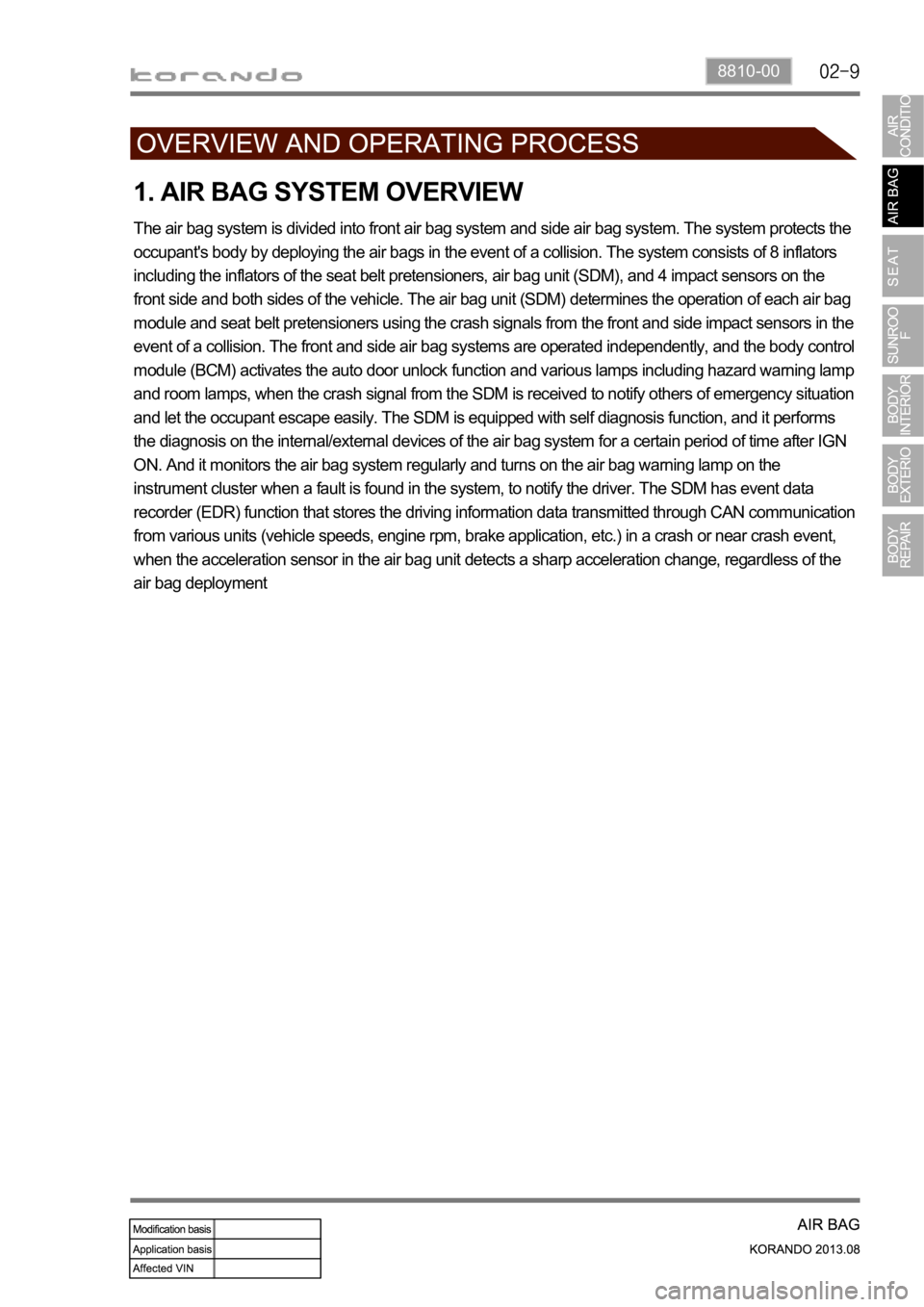
8810-00
1. AIR BAG SYSTEM OVERVIEW
The air bag system is divided into front air bag system and side air bag system. The system protects the
occupant's body by deploying the air bags in the event of a collision. The system consists of 8 inflators
including the inflators of the seat belt pretensioners, air bag unit (SDM), and 4 impact sensors on the
front side and both sides of the vehicle. The air bag unit (SDM) determines the operation of each air bag
module and seat belt pretensioners using the crash signals from the front and side impact sensors in the
event of a collision. The front and side air bag systems are operated independently, and the body control
module (BCM) activates the auto door unlock function and various lamps including hazard warning lamp
and room lamps, when the crash signal from the SDM is received to notify others of emergency situation
and let the occupant escape easily. The SDM is equipped with self diagnosis function, and it performs
the diagnosis on the internal/external devices of the air bag system for a certain period of time after IGN
ON. And it monitors the air bag system regularly and turns on the air bag warning lamp on the
instrument cluster when a fault is found in the system, to notify the driver. The SDM has event data
recorder (EDR) function that stores the driving information data transmitted through CAN communication
from various units (vehicle speeds, engine rpm, brake application, etc.) in a crash or near crash event,
when the acceleration sensor in the air bag unit detects a sharp acceleration change, regardless of the
air bag deployment
Page 1234 of 1336
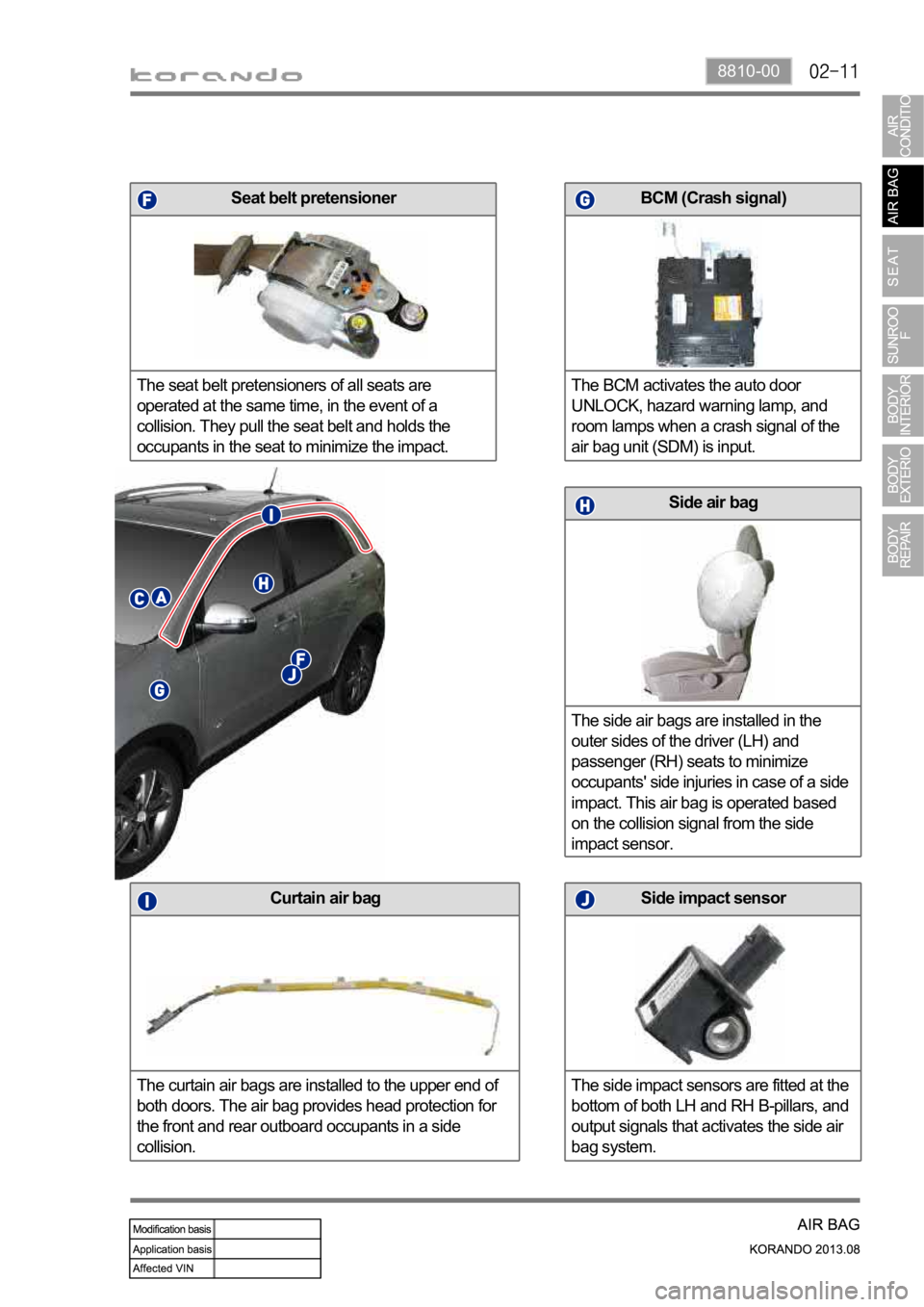
8810-00
Side air bag
The side air bags are installed in the
outer sides of the driver (LH) and
passenger (RH) seats to minimize
occupants' side injuries in case of a side
impact. This air bag is operated based
on the collision signal from the side
impact sensor.
Curtain air bag
The curtain air bags are installed to the upper end of
both doors. The air bag provides head protection for
the front and rear outboard occupants in a side
collision.Side impact sensor
The side impact sensors are fitted at the
bottom of both LH and RH B-pillars, and
output signals that activates the side air
bag system.
BCM (Crash signal)
The BCM activates the auto door
UNLOCK, hazard warning lamp, and
room lamps when a crash signal of the
air bag unit (SDM) is input.Seat belt pretensioner
The seat belt pretensioners of all seats are
operated at the same time, in the event of a
collision. They pull the seat belt and holds the
occupants in the seat to minimize the impact.
Page 1235 of 1336
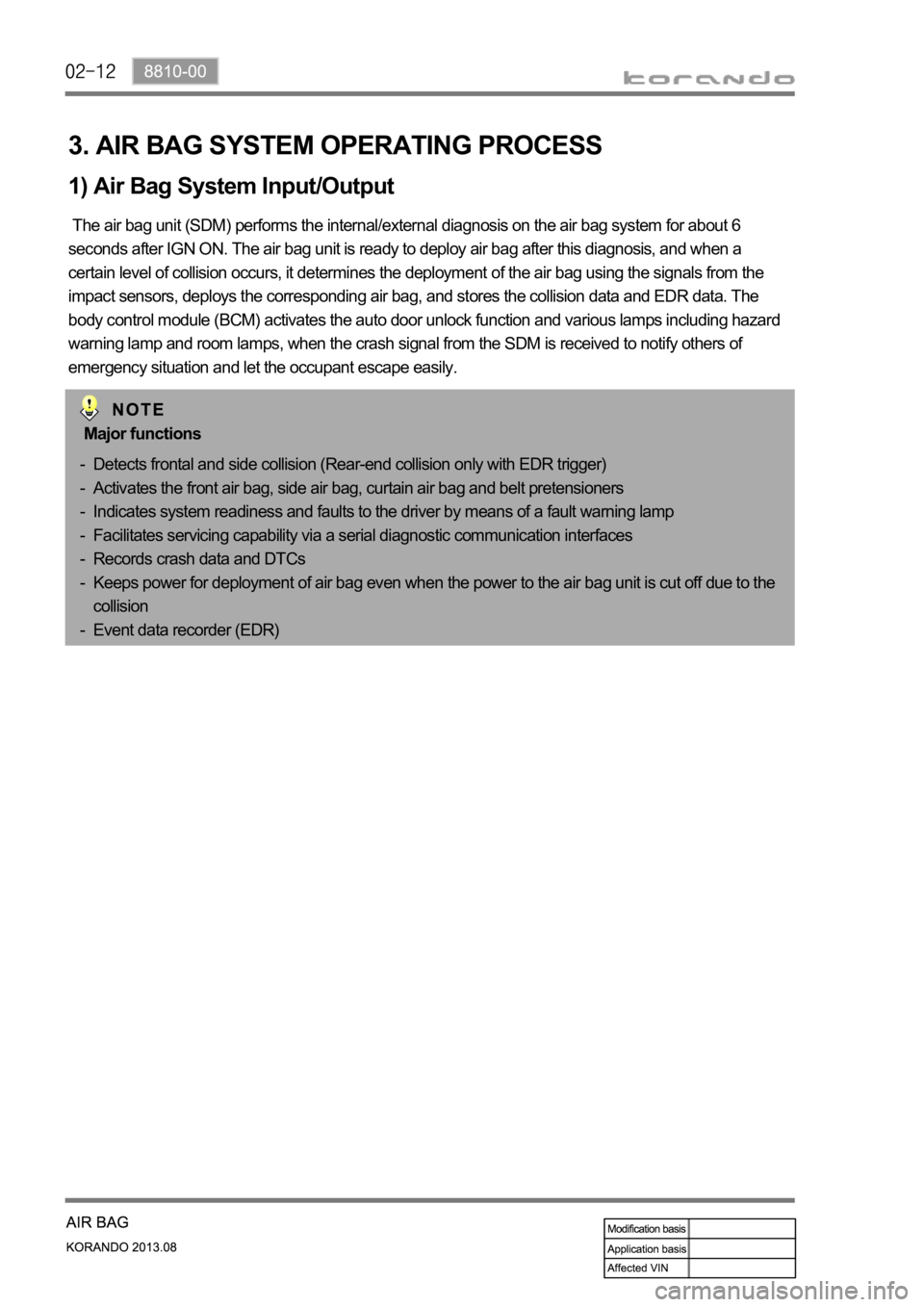
3. AIR BAG SYSTEM OPERATING PROCESS
1) Air Bag System Input/Output
The air bag unit (SDM) performs the internal/external diagnosis on the air bag system for about 6
seconds after IGN ON. The air bag unit is ready to deploy air bag after this diagnosis, and when a
certain level of collision occurs, it determines the deployment of the air bag using the signals from the
impact sensors, deploys the corresponding air bag, and stores the collision data and EDR data. The
body control module (BCM) activates the auto door unlock function and various lamps including hazard
warning lamp and room lamps, when the crash signal from the SDM is received to notify others of
emergency situation and let the occupant escape easily.
Major functions
Detects frontal and side collision (Rear-end collision only with EDR trigger)
Activates the front air bag, side air bag, curtain air bag and belt pretensioners
Indicates system readiness and faults to the driver by means of a fault warning lamp
Facilitates servicing capability via a serial diagnostic communication interfaces
Records crash data and DTCs
Keeps power for deployment of air bag even when the power to the air bag unit is cut off due to the
collision
Event data recorder (EDR) -
-
-
-
-
-
-
Page 1237 of 1336
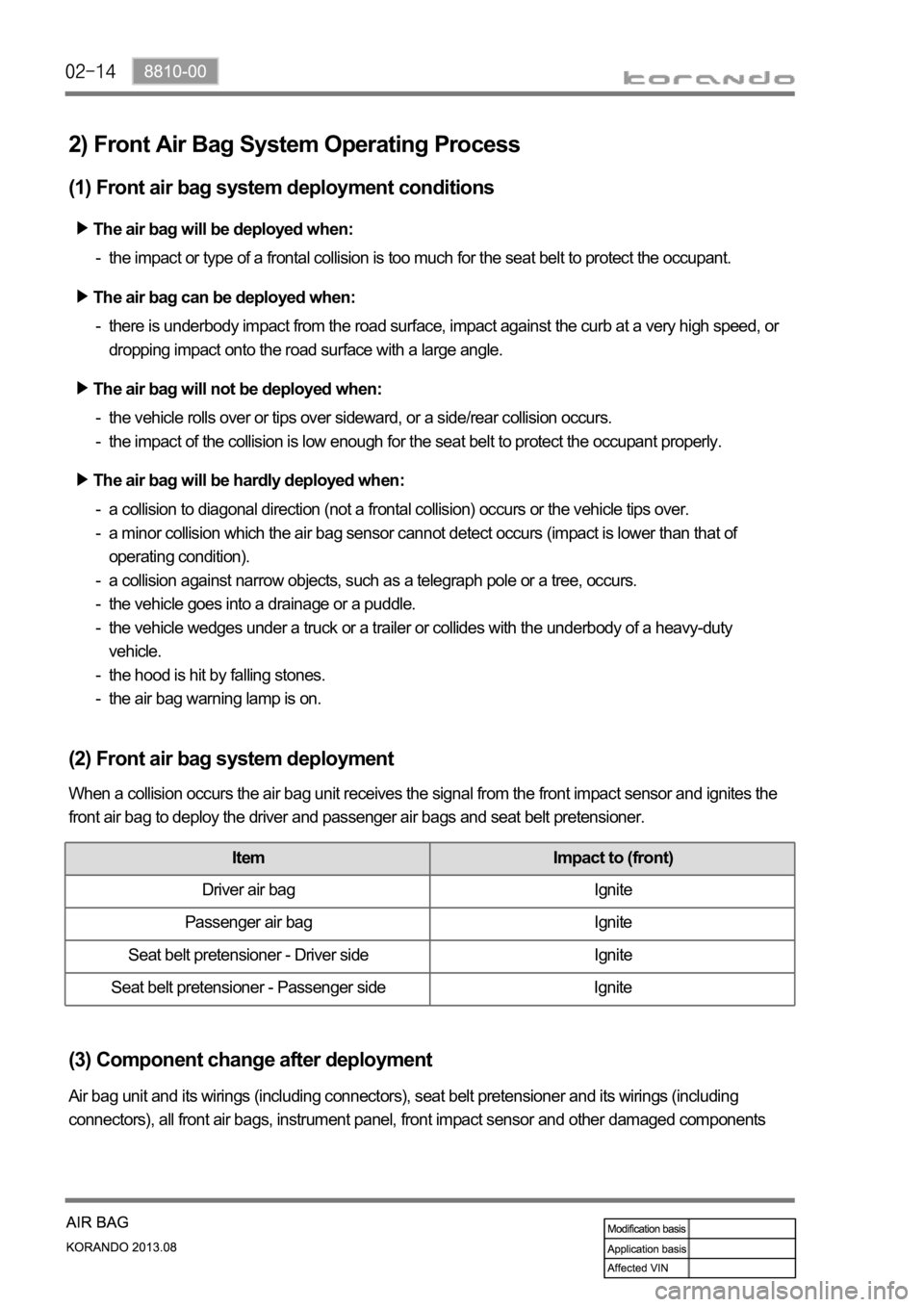
The air bag will be deployed when:
The air bag can be deployed when:
the impact or type of a frontal collision is too much for the seat belt to protect the occupant. -
a collision to diagonal direction (not a frontal collision) occurs or the vehicle tips over.
a minor collision which the air bag sensor cannot detect occurs (impact is lower than that of
operating condition).
a collision against narrow objects, such as a telegraph pole or a tree, occurs.
the vehicle goes into a drainage or a puddle.
the vehicle wedges under a truck or a trailer or collides with the underbody of a heavy-duty
vehicle.
the hood is hit by falling stones.
the air bag warning lamp is on. -
-
-
-
-
-
-the vehicle rolls over or tips over sideward, or a side/rear collision occurs.
the impact of the collision is low enough for the seat belt to protect the occupant properly. -
-
The air bag will be hardly deployed when:
2) Front Air Bag System Operating Process
(1) Front air bag system deployment conditions
there is underbody impact from the road surface, impact against the curb at a very high speed, or
dropping impact onto the road surface with a large angle. -
The air bag will not be deployed when:
(2) Front air bag system deployment
When a collision occurs the air bag unit receives the signal from the front impact sensor and ignites the
front air bag to deploy the driver and passenger air bags and seat belt pretensioner.
Item Impact to (front)
Driver air bag Ignite
Passenger air bag Ignite
Seat belt pretensioner - Driver side Ignite
Seat belt pretensioner - Passenger side Ignite
(3) Component change after deployment
Air bag unit and its wirings (including connectors), seat belt pretensioner and its wirings (including
connectors), all front air bags, instrument panel, front impact sensor and other damaged components
Page 1238 of 1336
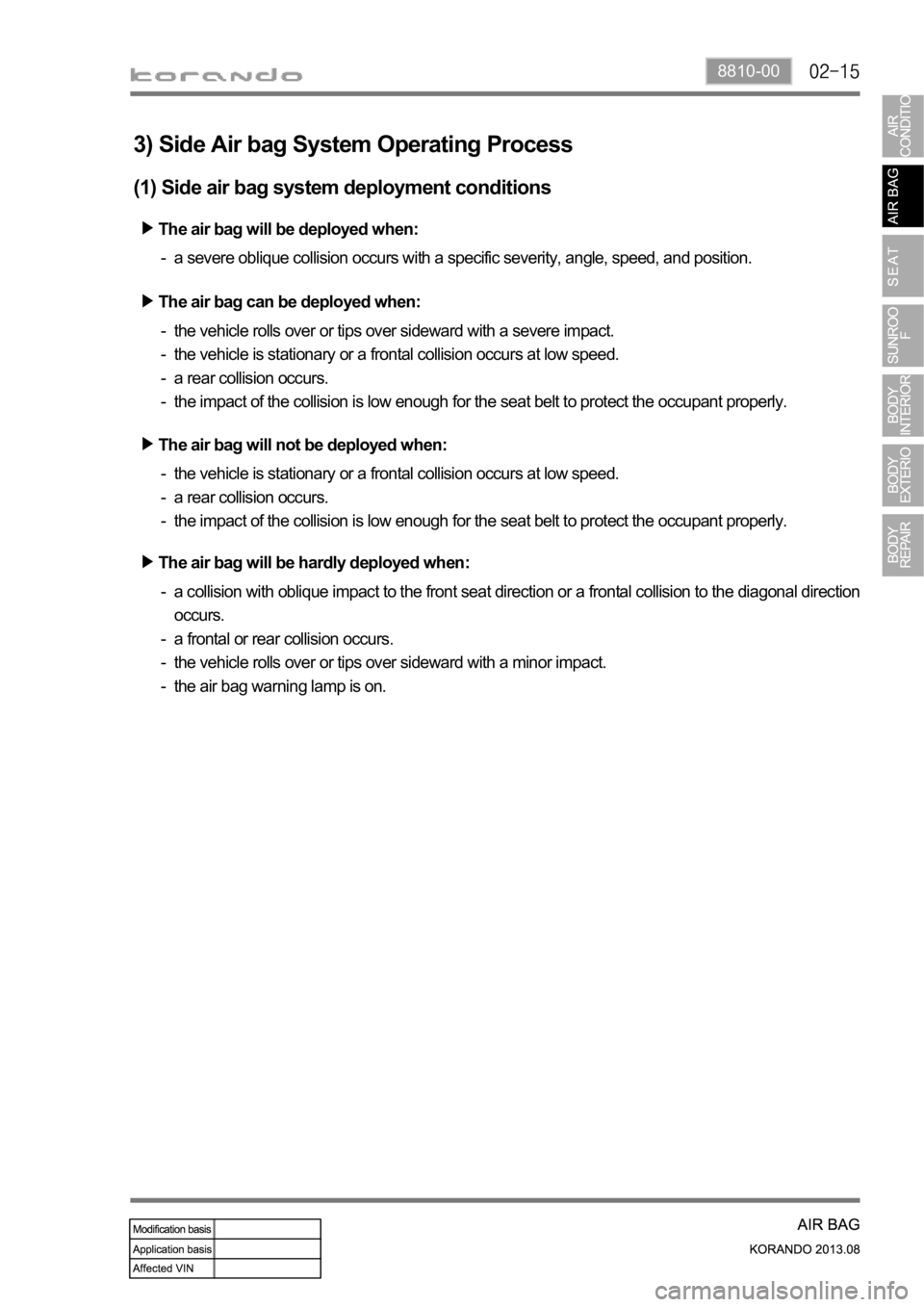
8810-00
The air bag will be deployed when:
The air bag can be deployed when:
a severe oblique collision occurs with a specific severity, angle, speed, and position. -
a collision with oblique impact to the front seat direction or a frontal collision to the diagonal direction
occurs.
a frontal or rear collision occurs.
the vehicle rolls over or tips over sideward with a minor impact.
the air bag warning lamp is on. -
-
-
-the vehicle is stationary or a frontal collision occurs at low speed.
a rear collision occurs.
the impact of the collision is low enough for the seat belt to protect the occupant properly. -
-
-
The air bag will be hardly deployed when:
3) Side Air bag System Operating Process
(1) Side air bag system deployment conditions
the vehicle rolls over or tips over sideward with a severe impact.
the vehicle is stationary or a frontal collision occurs at low speed.
a rear collision occurs.
the impact of the collision is low enough for the seat belt to protect the occupant properly. -
-
-
-
The air bag will not be deployed when:
Page 1239 of 1336
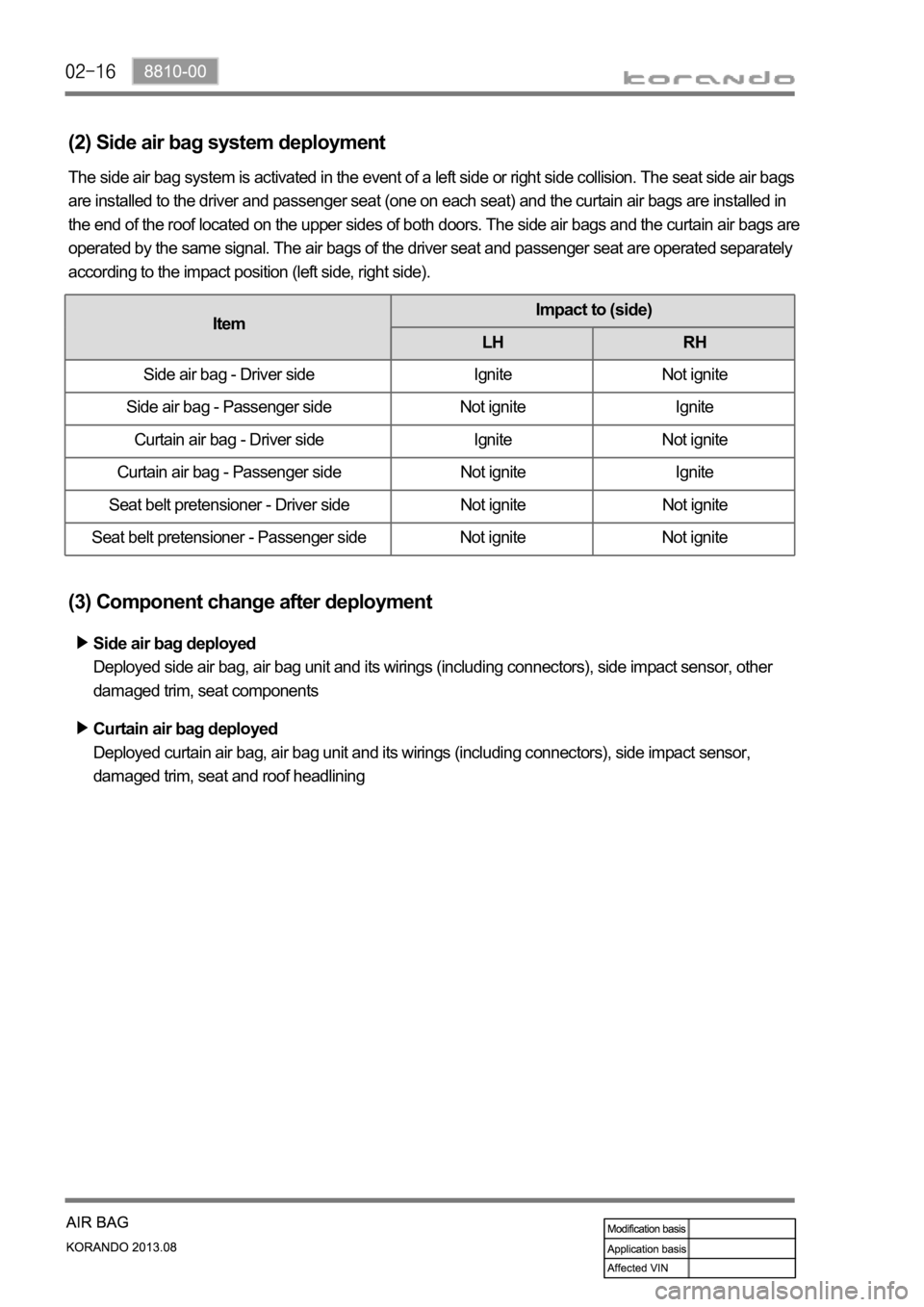
(2) Side air bag system deployment
The side air bag system is activated in the event of a left side or right side collision. The seat side air bags
are installed to the driver and passenger seat (one on each seat) and the curtain air bags are installed in
the end of the roof located on the upper sides of both doors. The side air bags and the curtain air bags are
operated by the same signal. The air bags of the driver seat and passenger seat are operated separately
according to the impact position (left side, right side).
ItemImpact to (side)
LH RH
Side air bag - Driver side Ignite Not ignite
Side air bag - Passenger side Not ignite Ignite
Curtain air bag - Driver side Ignite Not ignite
Curtain air bag - Passenger side Not ignite Ignite
Seat belt pretensioner - Driver side Not ignite Not ignite
Seat belt pretensioner - Passenger side Not ignite Not ignite
(3) Component change after deployment
Side air bag deployed
Deployed side air bag, air bag unit and its wirings (including connectors), side impact sensor, other
damaged trim, seat components
Curtain air bag deployed
Deployed curtain air bag, air bag unit and its wirings (including connectors), side impact sensor,
damaged trim, seat and roof headlining
Page 1241 of 1336

Seat belt pretensioner deployment
Original status 1.
Pretensioner operating 2.
Load limiter operating 3.
Inflator PistonThe piston and pinion in the seat belt
pretensioner are disengaged and the tension of
the return spring in it holds the occupant.
When the ignition current is transmitted from the
air bag unit to the ignition device of the seat belt
pretensioner, gas is generated from the inflator
and this pushes up the piston.
When the piston gear engages with the pinion
gear, the clutch is integrated and winds the seat
belt.
When the load on the seat belt increases and the
inner device stars being deformed, the pinion
rotates in reverse direction and the piston moves
downward. The residual pressure is released
through the vent hole of the piston when the
piston moves down. The gears of pinion and
piston are disengaged when the piston is located
at the lowest position. Pinion
Page 1258 of 1336
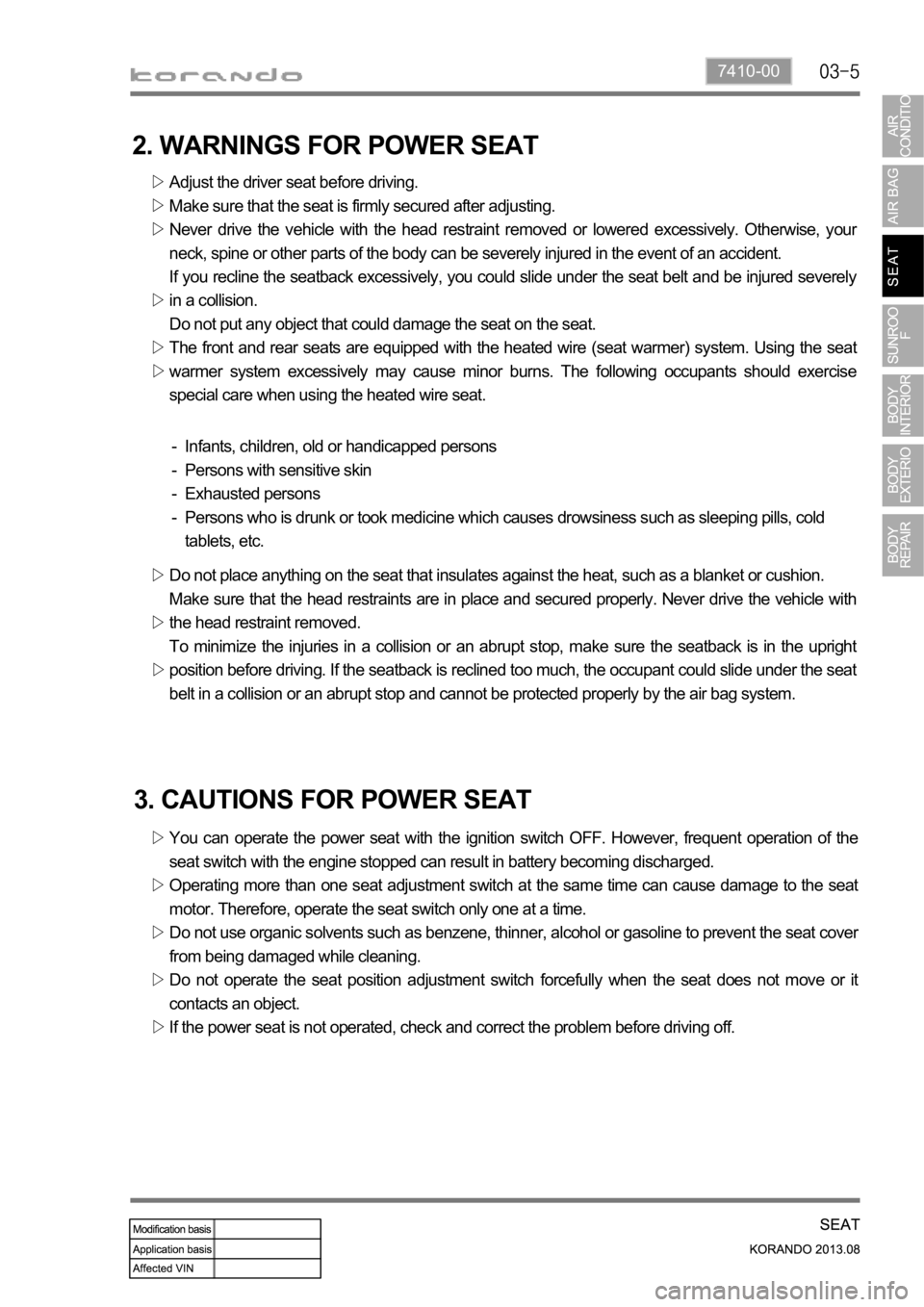
7410-00
2. WARNINGS FOR POWER SEAT
Adjust the driver seat before driving.
Make sure that the seat is firmly secured after adjusting.
Never drive the vehicle with the head restraint removed or lowered excessively. Otherwise, you
r
neck, spine or other parts of the body can be severely injured in the event of an accident.
If you recline the seatback excessively, you could slide under the seat belt and be injured severely
in a collision.
Do not put any object that could damage the seat on the seat.
The front and rear seats are equipped with the heated wire (seat warmer) system. Using the seat
warmer system excessively may cause minor burns. The following occupants should exercise
special care when using the heated wire seat.
Infants, children, old or handicapped persons
Persons with sensitive skin
Exhausted persons
Persons who is drunk or took medicine which causes drowsiness such as sleeping pills, cold
tablets, etc. -
-
-
-
Do not place anything on the seat that insulates against the heat, such as a blanket or cushion.
Make sure that the head restraints are in place and secured properly. Never drive the vehicle with
the head restraint removed.
To minimize the injuries in a collision or an abrupt stop, make sure the seatback is in the upright
position before driving. If the seatback is reclined too much, the occupant could slide under the seat
belt in a collision or an abrupt stop and cannot be protected properly by the air bag system.
3. CAUTIONS FOR POWER SEAT
You can operate the power seat with the ignition switch OFF. However, frequent operation of the
seat switch with the engine stopped can result in battery becoming discharged.
Operating more than one seat adjustment switch at the same time can cause damage to the seat
motor. Therefore, operate the seat switch only one at a time.
Do not use organic solvents such as benzene, thinner, alcohol or gasoline to prevent the seat cove
r
from being damaged while cleaning.
Do not operate the seat position adjustment switch forcefully when the seat does not move or it
contacts an object.
If the power seat is not operated, check and correct the problem before driving off.